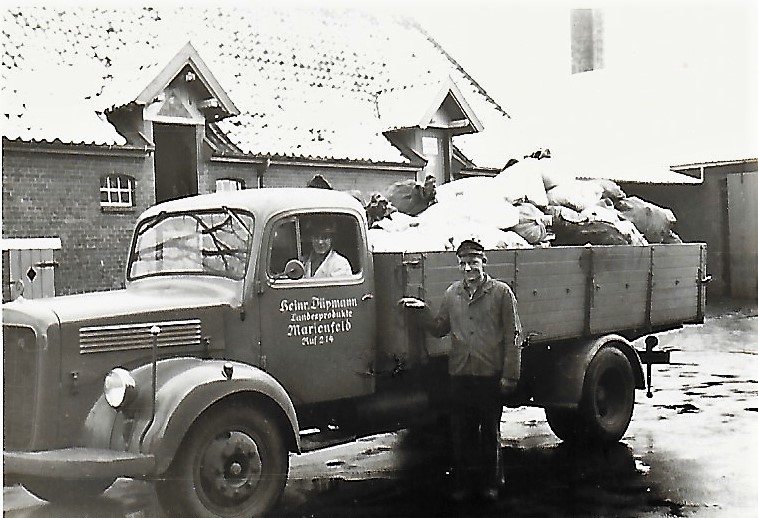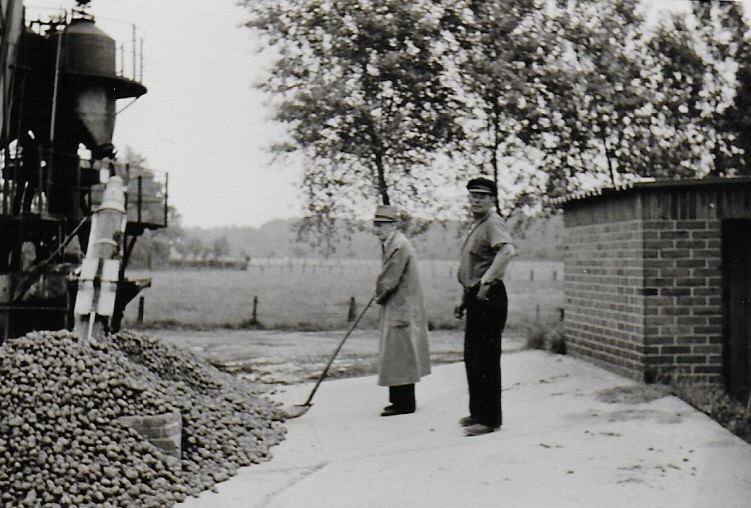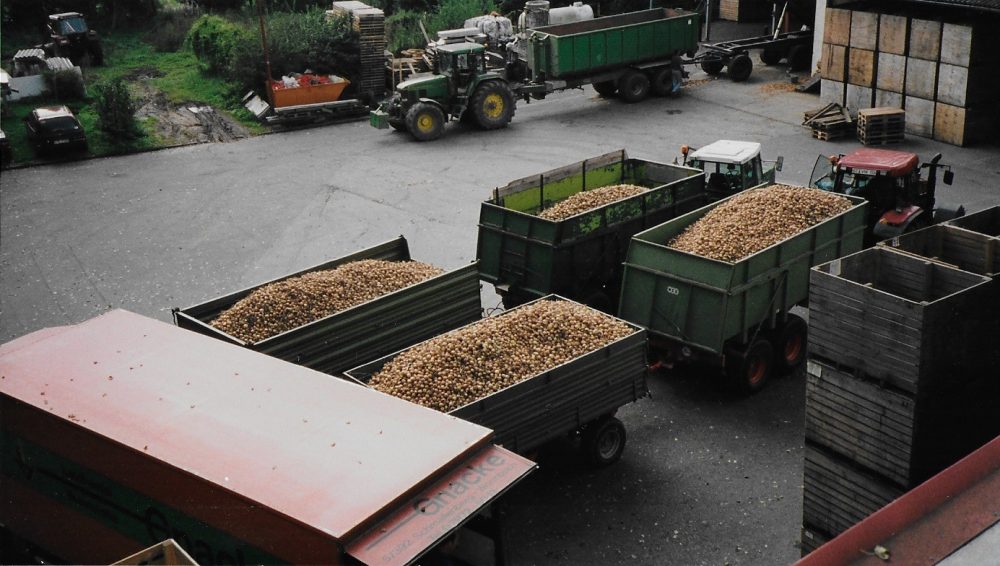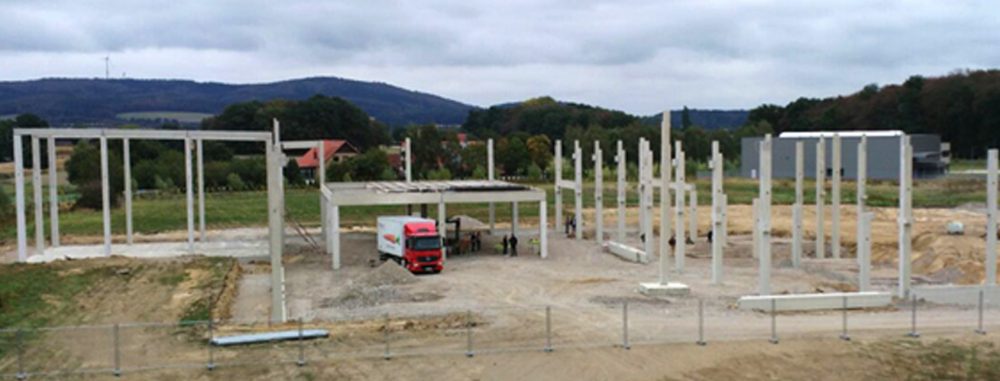Gemüseverarbeitung Düpmann - Success with history
Düpmann then and now...
We take you on an exciting journey into the past.
Founded in 1867
Anton Düpmann started his own business as a coachman in 1867. He transported the monks from the Marienfeld monastery to the surrounding monasteries, such as Clarholz, Liesborn and even further afield in Münsterland. Transportation of building materials and the delivery of live pigs were added later.
Trade in artificial fertilizers
At the beginning of the 20th century, artificial fertilizers were invented and this also marked the beginning of the trade and distribution of fertilizers at Düpmann. Initially, the fertilizer was still traded in sacks. In 1910, the goods were already being bought in bulk by wagon and from 1912, a reloading station was opened at Marienfeld railroad station.

Heinrich Düpmann
Heinrich Düpmann is the second generation to run the business. From 1914 to 1918, the First World War rages and all the men are drafted. His wife Anna continues to run the business alone. Anton Düpmann is killed in 1916. The business is further expanded after the war and a barn is built next to the residential building in 1919.
Expansion of the business
Further expansion work followed in 1921, and in 1923 and 1925, building after building was added, making the business ever larger. The Second World War begins in 1939. Heinirch Düpmann and his three sons are drafted. The business can therefore not be continued and has to be leased for almost 10 years. Heinrich Düpmann returns injured at the end of the war, but loses three sons in the war.
Rudolf Düpmann
The youngest son among the children is lucky: due to the large number of sacrifices in the family, he is not drafted. In the third generation, he starts working in his parents' business in 1950 after completing his commercial training. The business is continuously expanded. Fertilizers, animal feed, potato and coal trading are added. Even a restaurant is opened in 1951 . In 1952 , the company is managed in equal shares with his father Heinrich.
Large damping system
A stationary large-scale steaming plant is put into operation. Large quantities of fodder potatoes can now be steamed and delivered to farmers as feed. In 1955, the self-propelled Claas combine harvester is purchased. 1960 Rudolf Düpmann becomes sole managing director. In 1966 , his father Heinrich Düpmann passes away.

Construction of the ramp warehouse
With 600 square meters of floor space, the ramp warehouse goes into operation in 1961. The goods can now be loaded and unloaded much more easily. 1967 The sale of potatoes to various distilleries begins. 1970 The first potatoes are imported from Holland. Ready-peeled potatoes quickly establish themselves on the market. The customer base grows.
Start of onion peeling
After starting with the trade in peeled potatoes in 1970 , the company added its own production of hand-peeled onions in 1974 . The idea for this in-house production came from wife Margareta Düpmann. In 1976 , the first peeling machine from the Dutch company Finis was installed and further machines were added. In 1977, carrots, red and white cabbage can also be processed.
Heinz Düpmann
Heinz Düpmann is the fourth generation to start as a commercial employee in his parents' business. He continues to run the business together with his parents. In 1988 , direct imports of peeled onions from Poland began. In the same year, four farmers start growing onions under contract. The decision was made within the company in favor of contract farming. The company starts with a used sorting system. In 1990, the ramp warehouse is converted into an area storage facility for onions.

Storage and sorting hall
A real family business: Sons Roland(1988) and Burkhard(1990) are now also in the business. In 1991, a warehouse for 1,000 tons of onions and a hall for sorting and packing them is built. Machines for processing these goods are continually added. New peeling systems are also installed.
Construction of the peeling plant
In 2004 , the ramp warehouse is completely gutted and a new peeling plant is installed. In 2007 , the company receives IFS certification. In the same year, Rudolf Düpmann passes away. The demand for red and green bell pepper segments, for example for kebab skewers, continues to grow - Düpmann becomes colorful! The new extension is finally added in 2010 . Almost 1700 square meters of floor space ensure further growth. Expansion plans begin again in 2012 .
Borgholzhausen location
After a long period of planning, construction of a completely new site in Borgholzhausen begins on August 8, 2016. In addition to the production areas, Düpmann's first deep-freeze warehouse is also built, which went into operation in December 2017. The administration and a large part of the vegetable production have moved. Since 01.01.2018, the headquarters of Düpmann GmbH & Co. KG has been located in Borgholzhausen.

150 years of Düpmann
In July 2017, a big anniversary and inauguration party was held! The celebrations still took place in the shell of the building, but it was a great party with 300 invited guests. It was important that employees and their families were invited alongside customers, suppliers and family.
Borgholzhausen becomes the headquarters of Düpmann GmbH & Co. KG
Borgholzhausen has been the company headquarters since 01.01.2018. The administration area is completely finished. And the move also begins in production. In the middle of the current season, the machines in Marienfeld were dismantled at the weekend and reassembled in Borgholzhausen so that customers could be supplied with goods as usual at the start of the week. A strenuous task for the technical and production staff. The standard setters (IFS, Bio and QS) also had to come to terms with the unusual situation. In the end, all certifications at both locations were successfully completed. The IFS Broker is a new addition. This also makes it clear that trade now also plays a major role at Düpmann.
